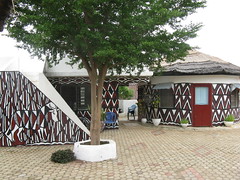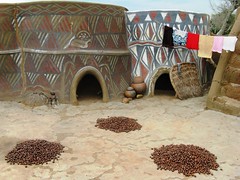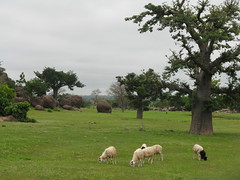On Monday, July 27th, I went to Sirigu, a village north of Bolgatanga where the Sirigu Women Organization for Pottery and Art(SWOPA) is located.
I first heard about SWOPA when I saw their paintings at the Loom Gallery in Accra back in February. The paintings on canvas are done in the traditional styles that resemble the wall paintings on their adobe homes. Colors are mainly earth tones of browns, blacks and whites with strong geometric shapes and symbols of animals (cows, pythons, crocodiles, chickens, fish). The geometric symbols may represent a broken calabash, or a male or a female.
SWOPA was founded by Melanie Kasise, who is the first woman in the community to receive a higher education. It is composed of women who will often work as a group on a painting. They are also experiementing with newer styles and their free styles which includes more colors. Their pottery consists of many styles as well, and SWOPA had a nice shop with very affordable prices.
I went on a tour and was shown different styles of houses. The homesteads I saw were drying millet and shea nuts. I tried some of the dried millet and it was quite tasty and crunchy. The homesteads also had silos to store the millet and adobe walled pens for their goats and chickens. The women were also applying black tar to their houses. I saw many women going to and fro from SWOPA with cans of black tar.
The homes had very unique doorways (photo above). They were created for protection during the slave trade. Whoever entered had to crawl to get in, thus leaving themselves vulnerable to a big whack on the head.
I went back to Sirigu again on Thursday, Sept. 24th and saw Asoikipala again. It was market day and she was busy preparing fried yams to sell. We walked through the market saying "Toma"(hello)to everyone. I bought some handmade ropes and also some kola nuts that I've read so much about. They are used a lot by workers because they give you energy. I ate one which was on the bitter side making my mouth dry. I didn't really notice a burst of energy and maybe should have tried some more to get their affects.
I did try their locally brewed millet beer called Pito. Asokipala and I stopped at an outdoor place where a woman had a large plastic barrel of Pito with many calabash bowls. She gave me a good amount in my bowl and we drank while talking with some of the men there. They enjoyed watching me try the millet brew. It was yeasty and looked maybe a little similar to a hefeweizen but with a bit stronger yeasty taste.
Besides the beautifully painted houses, Sirigu is also famous for "the elaborate facial scarring--almost like a spider's web in complexity--practised by the Nakarisi people (Ghana Bradt Guide, p.375).
-----------------
On July 26th, also a day trip from Bolgatanga, I went to Bongo, famous for the baobab trees and incredible rock formations. Some children met me along the way and escorted me through these amazing scupture-gardenesque rocks and trees. There were many grazing sheep and cows which gave the place a pastoral, almost English countryside feel that reminded me of the land of the Hobbits. We climbed up a hill and had incredible views of the countryside. It was definately an other worldy experience that felt like being in some kind of fairy tale book.
These are notes I took from a Ghana travel magazine (I don't remember its name) while I ate in a restaurant in Accra:
The baobob tree--its leaves contain vitamin C, sugar, potassium, calcium, leaves are cooked or crushed for later use. Seeds roasted as a coffee substitute. Baobob tree is an object of worship by Africans in the savannas. It has a foul smell. Its parts were used to ward off evil spirits. The baobob tree is a sacred tree and is also called God's thumb. It has a long life, can survive long periods of time without water and has many uses. People make soap, necklaces, glue, rubber, medicine, and cloth from the baobob tree. The spirits inhabit the flower of the baobob. Some believe if you pick a flower, you will be eaten by a lion. Drink an infusion of the bark and a man will become strong. Baby boys bathed in this infusion to become strong. Witches have their nocturnal meetings at the top of the tree.
Wednesday, October 7, 2009
Sirigu, SWOPA, Bongo--Northern Ghana
Labels:
Art,
baobob tree,
Bolgatanga,
Bongo,
Daniel Kerkhoff,
Ghana,
Loom Gallery,
northern Ghana,
Pito,
pottery,
Sirigu,
SWOPA
Subscribe to:
Post Comments (Atom)





This comment has been removed by a blog administrator.
ReplyDeleteThis comment has been removed by a blog administrator.
ReplyDeleteGreat Post! If you are in search of handmade products check Indego Africa.
ReplyDelete